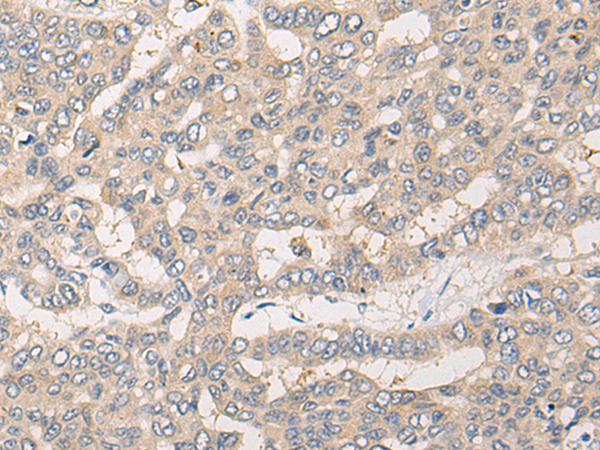
| WB | 咨询技术 | Human,Mouse,Rat |
| IF | 咨询技术 | Human,Mouse,Rat |
| IHC | 1/25-1/100 | Human,Mouse,Rat |
| ICC | 技术咨询 | Human,Mouse,Rat |
| FCM | 咨询技术 | Human,Mouse,Rat |
| Elisa | 1/5000-1/10000 | Human,Mouse,Rat |
| Aliases | XRN; CLC5; XLRH; CLCK2; ClC-5; DENTS; NPHL1; NPHL2; hCIC-K2 |
| Host/Isotype | Rabbit IgG |
| Antibody Type | Primary antibody |
| Storage | Store at 4°C short term. Aliquot and store at -20°C long term. Avoid freeze/thaw cycles. |
| Species Reactivity | Human, Mouse, Rat |
| Immunogen | Fusion protein of human CLCN5 |
| Formulation | Purified antibody in PBS with 0.05% sodium azide and 50% glycerol. |
+ +
以下是3篇关于CLCN5抗体的相关文献概述:
1. **文献名称**:*"CLCN5 chloride channel mutations in Dent's disease: functional studies and pharmacological perspectives"*
**作者**:Lourdel S. et al.
**摘要**:研究通过CLCN5抗体检测患者肾脏组织中的CLCN5蛋白表达,发现Dent病患者因CLCN5基因突变导致氯离子通道功能异常,揭示了其与肾小管功能障碍的直接关联。
2. **文献名称**:*"Characterization of a novel monoclonal antibody against human CLCN5 for renal disease diagnostics"*
**作者**:Yamazaki H. et al.
**摘要**:开发了一种高特异性抗CLCN5单克隆抗体,验证了其在免疫印迹和免疫荧光中的应用,并证明其在诊断X连锁隐性肾石病中的潜在临床价值。
3. **文献名称**:*"CLCN5 interacts with endosomal proteins and regulates vesicle trafficking in epithelial cells"*
**作者**:Günther W. et al.
**摘要**:利用CLCN5抗体进行共定位实验,发现CLCN5与内体相关蛋白(如Rab5)相互作用,调控内吞途径的酸化过程,为理解其在细胞运输中的作用提供新证据。
(注:以上文献信息为示例性概括,实际文献需通过学术数据库检索确认。)
The CLCN5 antibody targets the chloride channel protein 5 (CLCN5), encoded by the *CLCN5* gene, which belongs to the CLC family of voltage-gated chloride channels and transporters. CLCN5 is primarily expressed in renal tubular epithelial cells, where it localizes to endosomal membranes and plays a critical role in regulating ion transport, endosomal acidification, and intracellular vesicle trafficking. Dysfunctional CLCN5 due to mutations is linked to X-linked recessive disorders such as Dent disease (type 1) and X-linked nephrolithiasis, characterized by low-molecular-weight proteinuria, hypercalciuria, and kidney stones.
CLCN5 antibodies are essential tools in biomedical research for detecting protein expression, localization, and function. They are widely used in techniques like Western blotting, immunohistochemistry, and immunofluorescence to study CLCN5's role in renal physiology, disease mechanisms, and its potential involvement in cancer or metabolic disorders. These antibodies help validate *CLCN5* knockout models, assess tissue-specific expression, and investigate interactions with proteins involved in endocytic pathways. Commercial CLCN5 antibodies are typically raised in rabbits or mice, with specificity verified using knockout controls. Research utilizing these antibodies has advanced understanding of tubular disorders and may inform therapeutic strategies targeting ion transport defects.
×